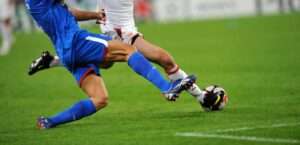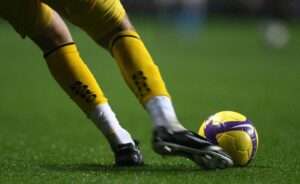Soccer requires much less equipment than most sports, with correct footwear being the only absolute necessity. The idea is to keep your gear light in order to allow for the widest possible range of movement and comfort over the whole 90 minutes. Here is a quick guide to what you will need to wear from head to toe:
Jersey
Most jerseys are made out of light synthetic fabrics, specially engineered to keep players dry. But these can be expensive and are hardly essential. Anything that fits loosely and comfortably, with long or short sleeves, is fine. More and more manufacturers have also been producing jerseys specifically to fit women. These tend to be closer fitting around the waist and the shoulders.
Shorts
There are very few rules for shorts since over the years players have worn everything from wide baggy ones to things that resemble small running shorts. Again, the rule of thumb should be comfort and freedom of movement. Only basketball-style shorts that fall below the knee are not recommended.
Socks
Soccer socks are typically made out of heavy cotton or a thick, durable synthetic fabric that reaches the knee. They should protect your feet from too much friction with your cleats and cover your shinguards. If you find they are sliding down your leg too much, many manufacturers produce stocking ties that fit just below the knee and are concealed when you fold the sock down.
Shin guards
Shin guards are extremely important at any level of soccer. Though they cannot prevent major breaks and serious injury, they will save you from the daily knocks and bruises that invariably find their way onto players’ shins. Shin guards fit on the front of your leg with Velcro straps and may or may not include a section designed to support your ankle. Strikers tend to wear smaller, lighter models, while defenders, midfielders, and goalkeepers tend to opt for designs that offer more coverage. Shin guards are also required to play in many recreational leagues.
Cleats
Cleats seem to come in dozens of shapes, sizes, and prices. The most important things are comfort and a close fit so that they offer full support through all the sudden starts, stops, and turns of soccer. It is also critical to make sure that your studs are suited to the type of surface you are playing on. Longer metal studs are for softer grass fields while shorter plastic studs are better for harder ground. Special shoes with rubber soles are also made for artificial turf and indoor settings.
Gloves
Goalkeepers are the only players who wear gloves all the time. Again, there are countless models out there so it is important to find a design that offers maximum mobility to your fingers and support to your wrists.
Players in the field sometimes wear gloves in cold conditions and there are no rules for these as long as they are light.
Headgear
Headgear is becoming more and more popular in soccer, particularly among youth players in the United States. Light and shaped like a headband, it is designed to soften the impact of heading the ball. It has also been shown to reduce the likelihood of injury in the event of two heads clashing.





